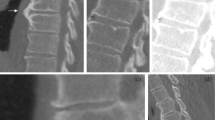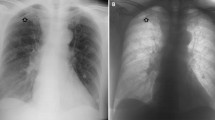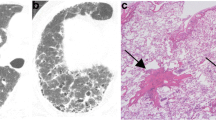Abstract
Purpose
To compare inter-reader variability of chest X-ray and high resolution computed tomography (HRCT) scans of formerly asbestos-exposed employees over a 4-year period.
Methods
In this longitudinal study, 636 formerly asbestos-exposed persons were annually examined with chest radiographs and HRCT scans. Ten observer pairs classified the radiographs and HRCT scans, using the ILO classification and a custom-made CT classification. Inter-observer variability was calculated using the κ-coefficient.
Results
Despite all expectations, HRCT inter-reader variability according to asbestos-related lung or pleura alterations at an early stage did not turn out to be better than X-ray inter-reader variability. Substantial inter-observer agreement was found for pleural calcifications (κX-ray = 0.63; κCT = 0.64). Averaging over κ led to fair inter-observer agreement of both methods (κX-ray = 0.36; κCT = 0.34).
Conclusions
High resolution computed tomography scans are superior to X-rays in detecting lung alterations after asbestos exposure and are supposedly easier to interpret. Nevertheless, inter-observer variability did not differ between the two methods in this study. This was probably due to the only discrete asbestos-related lung or pleura alterations of this cohort and to the unfamiliar CT classification sheet, which was revised on the basis of the presented results.

Similar content being viewed by others
References
Aberle DR, Gamsu G, Ray CS (1988a) High-resolution CT of benign asbestos-related diseases: clinical and radiographic correlation. Am J Roentgenol 151:883–891
Aberle DR, Gamsu G, Ray CS, Feuerstein IM (1988b) Asbestos-related pleural and parenchymal fibrosis: detection with high-resolution CT. Radiology 166:729–734
Akira M, Yamamoto S, Yokoyama K et al (1990) Asbestosis: high-resolution CT-pathologic correlation. Radiology 176:389–394
Akira M, Yokoyama K, Yamamoto S et al (1991) Early asbestosis: evaluation with high-resolution CT. Radiology 178:409–416
Banaei A, Auvert B, Goldberg M et al (2000) Future trends in mortality of French men from mesothelioma. Occup Environ Med 57:488–494
Bégin R, Ostiguy G, Filiion R et al (1993) Computed tomography in the early detection of asbestosis. Br J Ind Med 50:689–698
Bessis L, Callard P, Gotheil C et al (1992) High-resolution CT of parenchymal lung disease: precise correlation with histologic findings. Radiographics 12:45–58
Coenen W, Schenk H (1990) Ermittlung von Risikogruppen bei Asbestexponierten. Die BG: 71:8–726
Copley SJ, Wells AU, Rubens MB et al (2001) Functional consequences of pleural disease evaluated with chest radiography and CT. Radiology 220:237–243
De Raeve H, Verschakelen JA, Gevenois PA et al (2001) Observer variation in computed tomography of pleural lesions in subjects exposed to indoor asbestos. Eur Respir J 17:916–921
Edelman DA (1990) Does asbestosis increase the risk of lung cancer? Int Arch Occup Environ Health 62:345–349
Friedman AC, Fiel SB, Fisher MS et al (1988) Asbestos-related pleural disease and asbestosis: a comparison of CT and chest radiography. AJR Am J Roentgenol 150:269–275
Frumkin H, Pransky G, Cosmatos I (1990) Radiologic detection of pleural thickening. Am Rev Respir Dis 142:1325–1330
Hering KG, Tuengerthal S, Kraus T (2004) Standardisierte CT/HRCT-Klassifikation der Bundesrepublik Deutschland für arbeits- und umweltbedingte Thoraxerkrankungen. Radiologe 44:500–511
Impivaara O, Zitting AJ, Kuusella T et al (1998) Observer variation in classifying chest radiographs for small lung opacities and pleural abnormalities in a population sample. Am J Ind Med 34:261–265
International Labour Office/UC (1980) International classification of radiographs of pneumoconiosis. ILO, Geneva
Jarad NA, Wilkinson P, Pearson MC et al (1992) A new high resolution computed tomography scoring system for pulmonary fibrosis, pleural disease, and emphysema in patients with asbestos related disease. Br J Ind Med 49:73–84
Kjaergaard J, Andersson M (2000) Incidence rates of malignant mesothelioma in Denmark and predicted future number of cases among men. Scand J Work Environ Health 26:112–117
Kraus T, Raithel HJ (1998) Frühdiagnostik asbeststaubverursachter Erkrankungen. Hauptverband der gewerblichen Berufsgenossenschaften
Kraus T, Raithel HJ, Hering KG (1996) Evaluation and classification of high-resolution computed tomographic findings in patients with pneumoconiosis. Int Arch Occup Environ Health 68:249–254
Landis JR, Koch GG (1977) The measurement of observer agreement for categorical data. Biometrics 33:159–174
Levin SM, Kann PE, Lax MB (2000) Medical examination for asbestos-related disease. Am J Ind Med 37:6–22
Muir DCF, Bernholz CD, Morgan WKC et al (1992) Classification of chest radiographs for pneumoconiosis: a comparison of two methods of reading. Br J Ind Med 49:869–871
Musch DC, Higgins ITT, Landis JR (1985) Some factors influencing interobserver variation in classifying simple pneumoconiosis. Br J Ind Med 42:346–349
Suganuma N, Kusaka Y, Hering KG, International CT Classification Study Group et al (2006) Selection of reference films based on reliability assessment of a classification of high resolution computed tomography for pneumoconiosis. Int Arch Occup Env Health 79:472–476
Tiitola M, Kivisaari L, Zitting A et al (2002) Computed tomography of asbestos-related pleural abnormalities. Int Arch Occup Environ Health 75:224–228
Weiss W (1999) Asbestosis: a marker for the increased risk of lung cancer among workers exposed to asbestos. Chest 115:536–549
Welch LS, Hunting KL, Balmes J et al (1998) Variability in the classification of radiographs using the 1980 International Labor Organization Classification for Pneumoconioses. Chest 114:1740–1748
Acknowledgments
We would like to thank Dr. V. Wiebe, Dr. W. Raab, Dr. K. G. Hering, PD Dr. S. Tuengerthal and Prof. O. Wegener for their participation and support of this study.
Conflict of interest statement
The authors declare that they have no conflict of interest.
Author information
Authors and Affiliations
Corresponding author
Rights and permissions
About this article
Cite this article
Ochsmann, E., Carl, T., Brand, P. et al. Inter-reader variability in chest radiography and HRCT for the early detection of asbestos-related lung and pleural abnormalities in a cohort of 636 asbestos-exposed subjects. Int Arch Occup Environ Health 83, 39–46 (2010). https://doi.org/10.1007/s00420-009-0443-4
Received:
Accepted:
Published:
Issue Date:
DOI: https://doi.org/10.1007/s00420-009-0443-4




